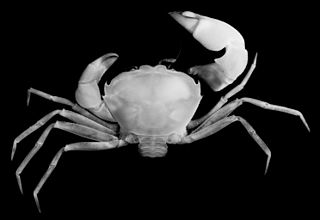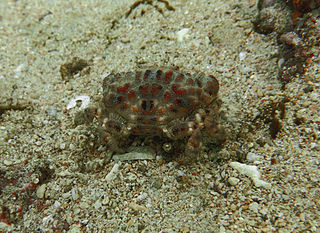
Anomura is a group of decapod crustaceans, including hermit crabs and others. Although the names of many anomurans include the word crab, all true crabs are in the sister group to the Anomura, the Brachyura.

Xanthidae is a family of crabs known as gorilla crabs, mud crabs, pebble crabs or rubble crabs. Xanthid crabs are often brightly coloured and are highly poisonous, containing toxins which are not destroyed by cooking and for which no antidote is known. The toxins are similar to the tetrodotoxin and saxitoxin produced by puffer fish, and may be produced by bacteria in the genus Vibrio living in symbiosis with the crabs, mostly V. alginolyticus and V. parahaemolyticus.

Majidae is a family of crabs, comprising around 200 marine species inside 52 genera, with a carapace that is longer than it is broad, and which forms a point at the front. The legs can be very long in some species, leading to the name "spider crab". The exoskeleton is covered with bristles to which the crab attaches algae and other items to act as camouflage.

Charybdis is a genus of swimming crabs in the family Portunidae. It is named after the monster Charybdis of Greek mythology.

Xanthoidea is a superfamily of crabs, comprising seven families. Formerly, a number of other families were included in Xanthoidea, but many of these have since been removed to other superfamilies. These include Carpilioidea, Eriphioidea, Hexapodoidea, Pilumnoidea and Trapezioidea. Even in this reduced state, Xanthoidea remains one of the most species-rich superfamilies of crabs.

Discoplax longipes is a species of terrestrial crab. It is found in karstic caves on Pacific islands and ranges from the Loyalty Islands to French Polynesia. Mating occurs in the caves, after which the females migrate to the sea to release their fertilised eggs. The genus Discoplax was for a long time synonymised with Cardisoma, but was resurrected in the late 20th century.

Trapezia is a genus of guard crabs in the family Trapeziidae. Like other members of this family, they live in association with corals, feeding on coral tissue and mucus, and defending the corals from predators, like starfish. It contains the following species:

Hexapodidae is a family of crabs, the only family in the superfamily Hexapodoidea. It has traditionally been treated as a subfamily of the family Goneplacidae, and was originally described as a subfamily of Pinnotheridae. Its members can be distinguished from all other true crabs by the reduction of the thorax, such that only seven sternites are exposed, and only four pairs of pereiopods are present. Not counting the enlarged pair of claws, this leaves only six walking legs, from which the type genus Hexapus, and therefore the whole family, takes its name. Some anomuran "crabs", such as porcelain crabs and king crabs also have only four visible pairs of legs. With the exception of Stevea williamsi, from Mexico, all the extant members are found either in the Indo-Pacific oceans, or around the coast of Africa.

Goneplacoidea is a superfamily of crabs containing 11 extant families, and two families known only from fossils.

Pilumnoidea is a superfamily of crabs, whose members were previously included in the Xanthoidea. The three families are unified by the free articulation of all the segments of the male crab's abdomen and by the form of the gonopods. The earliest fossils assigned to this group are of Eocene age.
Actinotocarcinus is an extinct genus of Miocene crab, and is the only genus in the subfamily Actinotocarcininae of the family Epialtidae, though was originally classified in the family Majidae. Actinotocarcinus comprises two species, A. chidgeyi, and A. maclauchlani, both from Miocene-aged marine strata of New Zealand.

Pseudozioidea is a superfamily of crabs, formerly treated in the Eriphioidea, Carpilioidea, Xanthoidea, Pilumnoidea and Goneplacoidea. A number of fossils from the Eocene onwards are known from the family Pseudoziidae. Eleven genera are recognised in three families:

Trapezioidea is a superfamily of crabs. Its members live symbiotically with corals and have a fossil record stretching back to the Eocene.

Ashtoret is a genus of crabs in the family Matutidae, containing the following species:

Xantho is a genus of crabs in the family Xanthidae, containing five extant species, all restricted to the north-east Atlantic Ocean and Mediterranean Sea, although Xantho granulicarpis is not universally recognised as a separate species from Xantho hydrophilus:

Zosimus aeneus, also known as the devil crab, toxic reef crab, and devil reef crab is a species of crab that lives on coral reefs in the Indo-Pacific from East Africa to Hawaii. It grows to a size of 60 mm × 90 mm and has distinctive patterns of brownish blotches on a paler background. It is potentially lethal due to the presence of the neurotoxins tetrodotoxin and saxitoxin in its flesh and shell.

Paractaea is a genus of crabs in the family Xanthidae, containing the following species:

Guinotellus melvillensis is a species of crabs in the family Xanthidae, the only species in the genus Guinotellus. It is a benthic crab with an ovate carapace within the subfamily Euxanthinae.
Linnaeoxanthus is a genus of crab, whose only species is Linnaeoxanthus acanthomerus. Linnaeoxanthus is the only genus of the family Linnaeoxanthidae.
Mithraculus cinctimanus is a species of crab in the family Majidae. It is found in the Caribbean region and is usually associated with a sea anemone, sponge or coral.
















